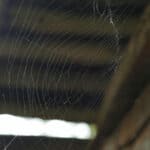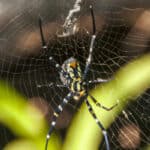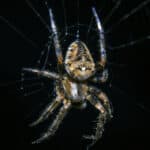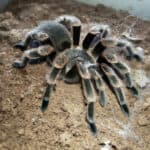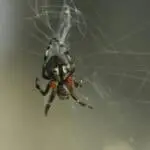As a jumping spider enthusiast, you may find yourself wondering how to tell if your spider’s egg sac is fertile. Jumping spiders are fascinating creatures, and their life cycle is a wonder to behold. Understanding the process of egg sac formation and protection, as well as the mating and reproduction habits of jumping spiders, can help you identify whether an egg sac is fertile or infertile.
Jumping spiders have a unique life cycle that sets them apart from other spider species. Unlike many other spiders, jumping spiders do not lay their eggs in a web. Instead, they create a silk-lined sac in which to lay their eggs. Once the eggs are laid, the mother spider will protect the sac until the spiderlings hatch. Identifying whether an egg sac is fertile or infertile can be challenging, but with the right knowledge and tools, you can easily determine the status of your spider’s eggs.
Key Takeaways
- Understanding the life cycle of jumping spiders is essential in identifying whether an egg sac is fertile or infertile.
- Jumping spiders create a silk-lined sac to protect their eggs until they hatch.
- Identifying the fertility of a jumping spider egg sac can be challenging, but with the right knowledge, it is possible to determine whether the eggs are viable or not.

Understanding Jumping Spiders
Jumping spiders are a type of arthropod belonging to the Salticidae family. These tiny creatures are known for their unique ability to jump up to 50 times their body length, making them one of the most agile creatures in the animal kingdom.
Jumping spiders are found all over the world and there are over 6000 known species. They are typically small, with most species measuring less than 1 cm in length. Despite their small size, they are known for their striking colors and patterns, which can vary widely between species.
One of the most interesting things about jumping spiders is their behavior. Unlike many other spiders, jumping spiders are active hunters and rely on their excellent vision to locate and capture prey. They are also known for their curious and inquisitive personalities, often approaching humans and other animals to investigate.
If you’re interested in keeping jumping spiders as pets, it’s important to understand their needs and behavior. Jumping spiders require a small and secure enclosure, with plenty of hiding places and climbing opportunities. They also need a varied diet of live insects, such as fruit flies, crickets, and moths.
Now that we’ve covered some basic information about jumping spiders, let’s take a closer look at how to tell if their eggs are fertile.
Spider Life Cycle
Jumping spiders, like all spiders, go through three main stages in their life cycle: egg, spiderling, and adult. After mating, the female jumping spider will lay eggs in an egg sac. The number of eggs in the sac can vary depending on the species, but it can range from a few to hundreds.
The egg sac is an important part of the spider’s life cycle. It protects the eggs from predators and other dangers. The sac can be either fertile or infertile. Fertile egg sacs are darker in color and covered in a sticky substance to keep the eggs inside. On the other hand, infertile egg sacs are lighter in color and do not have a sticky texture.
Once the eggs hatch, spiderlings emerge from the sac. They are tiny and vulnerable at this stage, but they will grow quickly. Spiderlings will molt several times before reaching adulthood. During this time, they will also hunt and feed to sustain their growth.
As spiderlings mature, they will molt less frequently and eventually reach adulthood. Female jumping spiders will become sexually mature and start producing their own egg sacs. Male jumping spiders, on the other hand, will start looking for a mate.
In summary, the life cycle of jumping spiders consists of three main stages: egg, spiderling, and adult. The egg sac is an important part of the spider’s life cycle, protecting the eggs until they hatch. Once the spiderlings emerge, they will grow quickly and molt several times before reaching adulthood. Female jumping spiders will eventually become sexually mature and start producing their own egg sacs, continuing the cycle of life.
Identifying Fertile and Infertile Eggs
As a jumping spider owner, it’s important to know whether the eggs laid by your spider are fertile or not. Here are some tips to help you identify whether the eggs are fertile or infertile:
-
Color and Shape: Fertile eggs are usually round and white, while infertile eggs can be misshapen or discolored. If you notice any discoloration or unusual shapes, it’s likely that the eggs are infertile.
-
Size: Fertile eggs are typically smaller than infertile eggs. If you notice that some of the eggs are larger than others, it’s possible that they are infertile.
-
Sac Appearance: The appearance of the sac can also give you a clue about whether the eggs are fertile or not. If the sac is small and tightly packed, it’s likely that the eggs are infertile. On the other hand, if the sac is large and loosely packed, it’s more likely that the eggs are fertile.
It’s important to note that even if the eggs are fertile, there’s no guarantee that they will hatch successfully. Jumping spiders are known for eating their own eggs, and even if they don’t, there are many factors that can affect the viability of the eggs.
In general, it’s best to leave the eggs alone and let nature take its course. If the eggs do hatch, be prepared to care for the spiderlings and provide them with the proper environment and food.
Mating and Reproduction
Jumping spiders are known for their unique mating behaviors. Unlike many other spider species, male jumping spiders do not spin webs to attract females. Instead, they use visual cues such as bright colors and elaborate dances to court females. Once a female has chosen a mate, the pair will engage in a complex mating ritual that can last for several hours.
During mating, the male will transfer sperm to the female using specialized structures called pedipalps. Once the female has been fertilized, she will begin producing eggs. Female jumping spiders are capable of producing multiple egg sacs throughout their lifetime, each containing dozens of eggs.
It can be difficult to determine whether a jumping spider egg sac is fertile or not. However, there are a few signs that can indicate whether the eggs are likely to hatch. One of the most reliable indicators is the presence of a gravid female. Gravid females are those that are carrying eggs and are visibly swollen with a round abdomen.
Another way to determine whether an egg sac is fertile is to observe the behavior of the female spider. Mated female spiders will often guard their egg sacs and keep them clean and free from predators. If you notice a female spider spending a lot of time near her egg sac, it is likely that the eggs are fertile.
It is important to note that not all eggs in a given egg sac will be fertile. Some may be infertile or may not develop properly. If you are interested in breeding jumping spiders, it is important to carefully monitor the behavior of your spiders and to provide them with the proper care and environment to ensure successful reproduction.
Egg Sac Formation and Protection
When a female jumping spider is ready to lay her eggs, she will begin to construct an egg sac. The sac is made from silk that is produced by specialized spinnerets located at the rear of the spider’s abdomen. The silk is carefully woven into a sac that will protect the developing eggs.
The shape and size of the egg sac can vary depending on the species of jumping spider. Some egg sacs are round, while others are oblong or even triangular in shape. The color of the sac can also vary, but it is usually white or cream-colored.
Once the egg sac is complete, the female spider will lay her eggs inside. The number of eggs in each sac can vary, but it is typically between 20 and 100. The female will then carefully protect the sac, often staying close by to guard it from predators.
The silk used to create the egg sac is incredibly strong and durable, providing excellent protection for the developing eggs. The silk is also waterproof, which helps to keep the eggs dry and safe from moisture.
Overall, the egg sac is a crucial part of the reproductive cycle for jumping spiders. It provides a safe haven for the developing eggs and ensures that they have the best possible chance of survival.
Raising Spiderlings
If you have successfully bred your jumping spider and have a sac full of eggs, congratulations! Now, it’s time to raise the spiderlings.
Once the spiderlings emerge, you can start feeding them small prey like fruit flies or other small insects. As they grow, you can gradually increase the size of their prey. You can also supplement their diet with a commercial insect food.
It is important to keep the enclosure clean and free of debris. You can use a small paintbrush to gently clean up any leftover food or waste. You should also provide a water source, such as a damp cotton ball or sponge.
As the spiderlings grow, you may need to transfer them to a larger enclosure. Be sure to provide plenty of hiding spots and climbing opportunities.
Remember, raising spiderlings can be a rewarding but challenging experience. It requires patience, attention to detail, and a willingness to learn. With proper care and attention, you can raise healthy and happy jumping spiderlings.
Common Jumping Spider Species
Jumping spiders are a diverse group of arachnids with over 6000 species worldwide. In North America alone, there are 35 known species of jumping spiders, including the bold jumping spider (Phidippus audax) and the regal jumping spider (Phidippus regius). These spiders are known for their unique hunting behavior, which involves stalking and pouncing on their prey.
While jumping spiders are generally harmless to humans, it is important to be aware of other spiders that may pose a threat. The black widow (Latrodectus spp.) and brown recluse (Loxosceles spp.) are two examples of spiders that can cause serious harm if bitten. It is important to know how to identify these spiders and take appropriate precautions to avoid them.
In addition to these potentially dangerous spiders, there are also many common spider species that are frequently encountered in and around homes. These include the wolf spider (Lycosidae spp.), garden spider (Araneus diadematus), and house spider (Tegenaria domestica). While these spiders are generally harmless, they can be a nuisance if they infest your home.
Overall, it is important to be aware of the different spider species that you may encounter in your daily life. By knowing how to identify these spiders and taking appropriate precautions, you can minimize your risk of encountering a potentially dangerous spider.
Community Resources and Help
If you are new to breeding jumping spiders, it is always helpful to have a community to turn to for support and advice. Luckily, there are several online forums and chat groups dedicated to arachnid enthusiasts that can help answer any questions you may have.
Arachnoboards is one such forum that is dedicated to the care and breeding of spiders, including jumping spiders. Here you can find a wealth of information on spider care, breeding, and genetics. The community is friendly and welcoming, and you can ask any questions you may have without fear of judgment.
Another great resource is the Tarantula Forum, which also has a section dedicated to jumping spiders. Here you can find discussions on breeding, egg sacs, and caring for spiderlings. The community is active and helpful, and you can often find answers to your questions just by browsing through the threads.
If you prefer a more immediate form of communication, there are also several chat groups dedicated to arachnid enthusiasts. Discord has several such groups, including the Arachnids and Inverts Discord server. Here you can chat with other enthusiasts in real-time and get answers to your questions quickly.
No matter which resource you choose, it is always helpful to have a community to turn to for support and advice. Whether you are a seasoned breeder or just starting out, there is always something new to learn about these fascinating creatures.
Location and Habitat
As the name suggests, jumping spiders can be found all over the world, from the tropical rainforests to the deserts. They are commonly found in grassy fields, gardens, and forests. In urban areas, they can be seen in parks and gardens.
Jumping spiders are known for their unique hunting techniques. They are active during the day and hunt for their prey by jumping on them. They are also known for their exceptional eyesight, which allows them to see their prey from a distance.
When it comes to nesting, jumping spiders do not build webs like other spiders. Instead, they create nests out of silk and leaves. These nests are usually found in crevices, under rocks, or in plants.
If you are lucky enough to come across a jumping spider nest, it is best to observe it from a distance. Jumping spiders are known for their aggressive behavior, and they may attack if they feel threatened.
Overall, jumping spiders can be found in a variety of locations and habitats. Keep an eye out for these fascinating creatures in your backyard or local park!
Predators and Survival
As with any species, jumping spiders face a variety of predators that threaten their survival. These predators include birds, insects, and other spiders. However, the egg sac provides a layer of protection for the developing spiderlings.
The silk material of the sac acts as a physical barrier, shielding the eggs from potential predators such as insects, birds, and other spiders. In addition, the sac provides camouflage for the eggs, making them harder to spot by predators.
Despite these protections, not all spiderlings will survive to adulthood. Some may fall victim to predators or environmental factors such as weather conditions or lack of food.
It is important to note that the survival of jumping spider egg sacs is not solely dependent on the presence of fertile eggs. Even if all the eggs are fertile, factors such as environmental conditions, predator activity, and the health of the mother spider can all impact the survival of the spiderlings.
Therefore, while determining the fertility of the egg sac is important for understanding the potential number of spiderlings that may hatch, it is not the only factor that determines the survival of the spiderlings.
Physical Attributes
When trying to determine whether a jumping spider egg sac is fertile, there are a few physical attributes to look out for. One of the most obvious signs is the size of the female spider’s abdomen. A larger abdomen can indicate that the spider has mated and is carrying eggs. However, it’s important to note that not all large abdomens are a sign of fertility, as some spiders may store sperm for a long time without laying eggs.
Another physical attribute to consider is the texture of the egg sac. Fertile egg sacs are usually smooth and round, while infertile egg sacs may be lumpy or misshapen. Additionally, the chelicerae and pedipalps of the female spider may be more pronounced when carrying a fertile egg sac.
It’s important to note that physical attributes alone are not always a reliable indicator of fertility. The only way to be certain is to wait for the eggs to hatch. However, if you’re eager to know whether your spider has laid fertile eggs, observing these physical attributes can give you a good indication.
In summary, when trying to tell if a jumping spider egg sac is fertile, look out for the size of the abdomen, the texture of the egg sac, and the prominence of the chelicerae and pedipalps. While these physical attributes are not a guarantee of fertility, they can provide helpful clues.
Miscellaneous
So, you’ve determined that your jumping spider has laid an egg sac. You’ve done your research and are now able to tell whether or not the eggs are fertile. But what else do you need to know about these tiny arachnids?
First of all, it’s important to note that jumping spiders are not the same as tarantulas. While they are both members of the arachnid family, they have some key differences. For example, jumping spiders are much smaller and more agile than tarantulas, and they do not have the same venomous bite.
If you’re a fan of football, you might be wondering if there’s any connection between jumping spiders and the NFL. While there’s no direct link, it’s interesting to note that some jumping spiders are able to detect and respond to visual cues in a way that’s reminiscent of a quarterback reading a defense.
Finally, if you’re looking for a sweet treat to enjoy while observing your jumping spider, you might want to consider baking some cookies. There are plenty of delicious recipes out there, and the aroma of freshly-baked cookies is sure to make your spider feel right at home. Just be sure to keep any crumbs or spills well away from your spider’s enclosure to avoid attracting unwanted pests.
Frequently Asked Questions
How long does it take for jumping spider eggs to hatch?
Jumping spider eggs take about 10-14 days to hatch. The time it takes for the eggs to hatch can vary depending on the temperature and humidity levels.
How often do jumping spiders lay eggs?
Jumping spiders can lay eggs multiple times throughout their lifetime. The frequency of egg-laying can vary depending on the species and environmental factors.
How many eggs do jumping spiders lay?
Jumping spiders can lay anywhere from 10 to 100 eggs in a single egg sac. The number of eggs laid can vary depending on the species and environmental factors.
Do female jumping spiders lay unfertilized eggs?
Yes, female jumping spiders can lay unfertilized eggs. However, these eggs will not hatch into spiderlings.
How do you tell the difference between fertile and infertile jumping spider eggs?
Fertile jumping spider eggs will be plump and firm, while infertile eggs will be runny or hard. Fertile eggs will also have a white spot on them, which is the developing spiderling.
What to do with infertile jumping spider eggs?
If you have infertile jumping spider eggs, you can discard them. It is important to note that jumping spiders are not endangered, so there is no need to try to save every egg sac. However, if you do want to try to hatch the eggs, you can place them in a container with a damp paper towel and wait to see if any spiderlings hatch.

